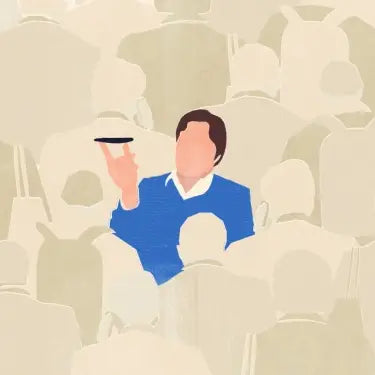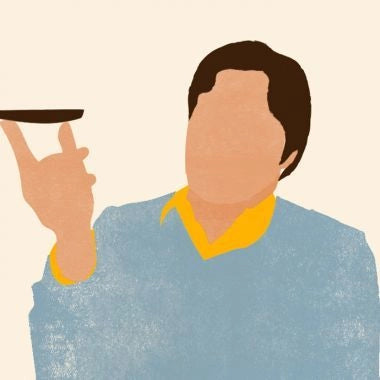It’s blissful.

Doing a digital detox
Plenty of people rave about the benefits of switching your smartphone for a dumbphone and taking some time to unplug. I’ve read about it. A lot. And along the way, I’ve admired the Punkt. MP01 – a so-called ‘dumbphone’ – from afar. It’s like that old Nokia you had back in the day, but better designed, with fancy birdsong ringtones, and no games. Not even Snake. In fact, it doesn’t do much except make calls, send texts, and serve as your morning alarm.
The catch: at the time it came with a £229 price tag. That seemed a little steep to me, no matter how nice the phone looks. (It's now £175) If I really want to do a digital detox, I can use the £10 Nokia in the bottom of my drawer, right? Right! Except I haven’t done it.
Then I received Punkt.’s newsletter a few weeks ago. They were looking for people who’d be willing to try a digital detox and write about their experience in exchange for an MP01. I applied and was accepted.
So here I am. Digitally detoxing.
The timing couldn’t have been more perfect. Punkt. said the MP01 was due to arrive on Tuesday 13th February – the day before the start of Lent. I’d been growing increasingly hungry to try a digital detox and this was the perfect opportunity; at 40 days, Lent’s a long enough time to be a meaty challenge, but not so long that it seems impossible. (Punkt.’s detox guidelines suggest putting your smartphone away for two days, which seems a little easy.)
The MP01 arrived in a fancy box of the kind of quality you’d expect from a new Apple gadget. The phone itself felt lighter and more plasticky than I’d expected, but still looked pretty. (I’d have preferred the black version but it wasn’t an option.) I’d already ordered a new SIM card from GiffGaff, as my regular Three SIM card doesn’t support the 2G network, which the MP01 runs on. So I popped it in and switched on.
It took me all of two minutes to explore the features. (There are no features.) Then I started to think about the practicalities of the next 40 days. How was I going to tell people that I had a new number? What about the clients I work with who might need to reach me on my old number? Did I need to email everyone I know? After all, I was probably only going to have this number for a month. And what about all the urgent social media notifications I might miss out on?
In the end, this is what I decided to do:
- Check my social media notifications once a day, just in case there’s anything urgent that I need to reply to. I won’t look at the feeds, just my notifications. Turn my iPhone on every few days to pick up any stray texts or messages.
- Email my new number to select friends and family. Only the people I speak to pretty regularly.
- Change my email signature to let people know about my new number, and the fact that I might be slower to get back to them than usual.
- Carry my iPhone (turned off) for emergencies. My sense of direction is beyond appalling and I don’t want to be late for anything important. Without the help of Google Maps, I’ve been known to cycle miles in the wrong direction.
Day 1 – Wednesday 14th February
I wake up to two missed calls from an unknown number. This makes sense, because the only number I have saved in my new phone is my wife’s, so any other number is going to be a mystery. After an investigatory text (‘Who is this’ – no punctuation because I can’t find the right button) I discover it’s my brother, Steve, no doubt calling because he’s amused by my little challenge.
Over breakfast, I read a magazine. I haven’t checked my email yet (or anything else) because my laptop remains closed on my desk. I can’t think of the last time I haven’t checked my email as soon as I wake up. It’s blissful. I’m working from home today so at 9am I wander into my home office and turn on the computer. There are a few emails to deal with but nothing urgent. Then, rather than doing the usual cycle of checking all my social networks, I open up my to-do list and see what’s in store.
The day continues like this. Without the distraction of my phone bleeping, and with no opportunity to quickly check Instagram every half an hour, I get a surprising amount of work done. More than that, I feel weightless. Airy. Peaceful. In a Zen-like state. I go to the loo without looking at Twitter. I ponder the photos on the toilet wall. I get bored while I wait for the kettle to boil. I think about things as I brush my teeth. I have free time. It’s wonderful.
In the afternoon, I lead a copywriting workshop in Waterloo. Before I head off, I look up the directions and write them down in my notebook. On the Tube ride there, I finish up some of the workshop prep and then pull out a book. Most of the people around me are glued to their smartphones. I don’t miss mine. As I leave the workshop at the end of the day, I realise I haven’t checked my emails since lunchtime. It feels great. Annabel calls me on the MP01 as I walk back to the Tube station and we arrange to meet at home and make dinner.
Day 2 — Thursday 15th February
I wake up early and head to breakfast with one of my three phone contacts, Jack. He texted me the night before to ask where we were meeting. Every word I type on the MP01 is a painstaking labour of love, so I replied with a short message suggesting a café in Clerkenwell. I can’t even send him an appropriate Bitmoji1.
The café deals in Irish home cooking and I’m intrigued by something called a ‘boxty’. Not knowing what it is and unable to Google it, I ask the waitress and she tells us that it’s a potato pancake. Jack and I both go for it and discover that it’s basically mashed potato, slightly fried. I’m glad I’ve tried it but wouldn’t order it again. I’m unable to post an amusing tweet of my boxty review.
I spend the rest of the day working at a nearby marketing agency before returning home. Because my job involves being on a computer all day, I’m still subject to all the same email notifications, with internet fun only a click away. But I manage to hold off from checking social media and only have one graze of the Guardian homepage. Without the usual distractions, I get my work done a lot quicker and have time to handle some pressing items on my to-do list.
In the evening, Pat and Dave come around for dinner and we spend a lot of time talking about death, and also things to do in London. Without my phone to make a note of things, and having left my notebook in another room and being too lazy to fetch it, I pester Annabel to email me names of things so I can check them out in the morning. We play music through our Sonos, but I can’t control it without my phone. So I borrow Annabel’s to put on some S. Carey2.
After two days of my iPhone being switched off, I turn it on to photograph the MP01 for this blog. Then I turn it off again.
A digital detox takes a turn
I haven’t really described why I wanted to do a digital detox. And as I’ve wrestled with switching back to my iPhone – although carrying on with elements of the detox – it’s made me think about what I wanted from this Lent period.
I don’t think smartphones are intrinsically bad. But I do think some of the ways we use them are pretty damaging. With a digital detox, I wanted to:
- Stop checking emails and social media first thing in the morning, last thing at night, and multiple times throughout the day.
- Stop filling every bit of free time – walking to the Tube, brushing my teeth, sitting on the toilet, waiting for the kettle to boil, standing in a queue – with my phone.
- Escape the constant outrage, one-upmanship and snark of Twitter.
- Take respite from the exhaustion of non-stop news.
- Have a break from comparing myself with other people’s lives on Instagram, and boasting about my own.
- Not get sucked into the cesspit of Facebook.
- Make a tiny sliver of space in my mind to actually think.
Using the MP01 helped with all of the above. It was a glorious week, as I wrote in my first post.
But it also caused a few problems.
- I missed a couple of important phone calls when people tried to reach me on my usual number.
- I got lost on the way to a meeting, which resulted in a string of frantic phone calls to Annabel, who attempted to remedy the situation from her workplace. (It’s worth noting that I get stressed out when I’m lost. It’s also worth noting that despite being twenty minutes late, my host didn’t mind. But I did.)
- Some people didn’t know how to reach me – which defeated the object of having richer levels of communication.
- There were myriad minor annoyances where I resorted to fetching my iPhone from my bag to remedy the situation.
It wasn’t missing social media that made me crack. It was the practical stuff – needing directions, not being able to pull up an email with critical information, missing phone calls – that caused the inconvenience.
The MP01 made life more complicated – in some ways, at least. And that’s not what this challenge was about. I wanted to make life simpler, more meaningful.
Our smartphones can make life simpler, and they have done. But it’s important that we keep them in their place.
I want access to the weather, to maps, to my entire email inbox at any time. I want to be able to message my friends for free when they’re travelling in different countries.
But I don’t want the constant distraction, the endless notifications, the compulsion to check my phone at every available opportunity.
For the rest of Lent, I’ll be on my iPhone. But the notifications are off and I won’t be checking Instagram on the loo. And, fingers crossed, I won’t be getting lost again. Well, not without maps to save me.
Luke Leighfield









